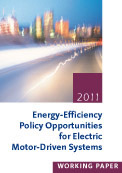The report, titled “Energy-Efficiency Policy Opportunities for Electric Motor-Driven Systems (EMDS),” proposes a comprehensive package of policy recommendations to help governments realize the potential for efficiency-based energy savings in EMDS, currently the single largest electricity end-use, accounting for more than 40% of global electricity consumption.
 May 2011: The International Energy Agency (IEA) has published a report titled “Energy-Efficiency Policy Opportunities for Electric Motor-Driven Systems.” This report represents the first global analysis of energy consumption and energy efficiency potential of electric motor-driven systems (EMDS).
May 2011: The International Energy Agency (IEA) has published a report titled “Energy-Efficiency Policy Opportunities for Electric Motor-Driven Systems.” This report represents the first global analysis of energy consumption and energy efficiency potential of electric motor-driven systems (EMDS).
The report proposes a comprehensive package of policy recommendations to help governments realize the potential for efficiency-based energy savings in EMDS, currently the single largest electricity end-use, accounting for more than 40% of global electricity consumption. The paper begins by introducing EMDS, their applications and market data. It continues by outlining global electricity consumption and carbon dioxide emissions, followed by discussions of: energy-saving technologies and savings potentials applicable to EMDS; the economics of energy savings in EMDS; barriers to optimization of efficient EMDS; energy-efficiency policy experience for EMDS; and options and recommendations for new policies on EMDS.
Stressing that the energy efficiency of EMDS has been relatively neglected in comparison with other sustainable energy opportunities, the report concludes that improving the efficiency of EMDS systems could reduce total global electricity demand by about 10%. To this end, the report formulates five regulatory policy recommendations, and four non-regulatory policy recommendations.
For regulatory policy, it recommends that: minimum energy performance standards (MEPS) be introduced for electric motors in IEA member countries based on international best practice standards; MEPS and energy labeling be introduced for packaged integrated motor‐driven energy end‐uses; energy performance test procedures be developed for all motor types; energy‐performance test procedures covering other essential components be developed and put in place; and the feasibility of minimum energy performance standards for certain classes of gears and transmissions be explored.
For non-regulatory policy, it recommends that: large‐scale awareness programmes be developed to inform industrial and commercial electricity users of the significant savings potential possible via EMDS; incentive schemes be developed and applied to encourage adoption and use of best practices; international capacity‐building efforts be substantially expanded to create permanent support structures; and global market monitoring be established at defined intervals to support national regulation and incentive programmes with market‐transformation data. [Publication: Energy-Efficiency Policy Opportunities for Electric Motor-Driven Systems] [Executive Summary]